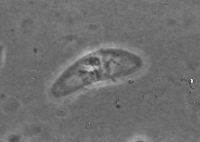- Myxosporea
-
Myxosporea Scientific classification 
Kingdom: Animalia Phylum: Cnidaria (unranked): Myxozoa Class: Myxosporea
Buetchli 1881Orders - Bivalvulida
- Multivalvulida
The Myxosporea are a class of microscopic parasites, belonging to the Myxozoa. They have a complex life cycle which comprises vegetative forms in two hosts, an aquatic invertebrate (generally an annelid) and an ectothermic vertebrate, usually a fish. Each host releases a different type of spore. The two forms of spore are so different that until recently they were treated as belonging to different classes within the Myxozoa.
Contents
Spore morphology
Myxosporean stage
In the vertebrate host, organisms belonging to the Myxosporea are characterised by spores composed of several cells, contained within between 1 and 7 shell "valves". These cells include 1 or two amoeboid infective germ cells, and 2 to 7 nematocyst-like polar capsules. During some stages of the life cycle, the germ cells are completely contained within cells of the host.
 Alataspora solomoni, a myxosporean parasite found in the gall bladder of Atlantic Horse Mackerel. This species has two "valves" arranged in a banana-shape, with two polar capsules, one on either side of the suture between the valves
Alataspora solomoni, a myxosporean parasite found in the gall bladder of Atlantic Horse Mackerel. This species has two "valves" arranged in a banana-shape, with two polar capsules, one on either side of the suture between the valves
The myxosporean species are typically defined by the size and shape of the spores released by vertebrate hosts. For instance, the genus Ceratomyxa is a common parasite of the gallbladder of many fish species; they have "boomerang-like" spores with two polar capsules resembling eyes in the middle of the spore. Most species within the myxosporea are sized between 10 µm and 20 µm, however Myxidium giganticum is up to 98 µm long.
The spore shell consists of shell "valves", which are joined together along "suture lines". Some species contain polysaccharide reserves in the form of β-glycogen particles, which are concentrated in a central "iodinophillous vacuole".
The shell valves may have smooth or ridged surfaces, may be drawn out into lateral "alate" projections, and may or may not have a mucous coating. These adaptions probably serve to increase the buoyancy of the spore in the water column, aiding dispersal. The valves are formed of resistant, non-keratinaceous protein.
Actinosporean stage
The alternate stage of the life cycle is generally released by an annelid or polychaete worm, typically resembles three or four hooks united by the base, and can also be used for identification. These organisms were classified in the class Actinosporea, until careful experimentation supported by analysis of the 16S Ribosomal Subunit RNA sequence in the early 1990s allowed matching of several actinosporeans with their myxosporean equivalent.
Taxonomic status
The taxonomy of both actinosporeans and myxosporeans was originally based on spore morphology. Recently Kent et al. (1994) redefined the phylum Myxozoa to solve the taxonomic and nomenclatural problems arising from the two host life cycle of myxozoans as first described by Wolf and Markiw (1984). The distinction between the two previously recognised classes Actinosporea and Myxosporea disappeared and the class Actinosporea was suppressed, becoming a synonym of the class Myxosporea Bütschli, 1881. The generic names of actinosporeans were retained as collective "type" names, and it was proposed that they be used to characterise different morphological forms of actinosporeans. Actinosporeans, for which the myxosporean stage is not known, are to be retained as species inquerandae until their specific identity is established.
Transmission
Until the 1980s, direct transmission of myxosporeans was presumed. In 1984, it was shown experimentally that spores of Myxobolus cerebralis failed to produce infections when fed to salmonids (Wolf & Markiw, 1984). To reproduce successfully, this species requires a tubificid worm as an intermediate host, in which the spores develop into a "species" of the "genus" Triactinomyxon. These spores develop inside the oligochaete into forms which are infective to salmonids. Such a life cycle, with two different sexual stages, resulting in two kinds of resistant spores, is unique amongst the parasitic organisms. This mode of life cycle has been confirmed in several other Myxobolus species.
This mode of infection has also been proved in other families. Ceratomyxa shasta, an economically important parasite of salmonids, has been shown to use a polychaete worm as an alternate host. Surprisingly, however, direct transmission between fish has also been demonstrated, so far in three species of Enteromyxum.
Examples of Myxosporean genera are Kudoa, which attacks fish muscle, and Myxobolus, which attacks the hearts of freshwater fishes.
Cited literature
- Bartholomew, J. L., M. J. Whipple, D. G. Stevens and J. L. Fryer. (1997). The life cycle of Ceratomyxa shasta, a myxosporean parasite of salmonids, requires a freshwater polychaete as an alternate host. American Journal of Parasitology. 83:859-868.
- Wolf, K. & Markiw, M.E. (1984). Biology contravenes taxonomy in the Myxozoa: new discoveries show alternation of invertebrate and vertebrate hosts. Science 225:1449-1452
- Kent, M. L., Margolis. L., & Corliss, J. 0. (1994). The demise of a class of protists: Taxonomic and nomenclatural revisions proposed for the protist phylum Myxozoa Grasse, 1970. Canadian Journal of Zoology 72:932-937.
Categories:
Wikimedia Foundation. 2010.
